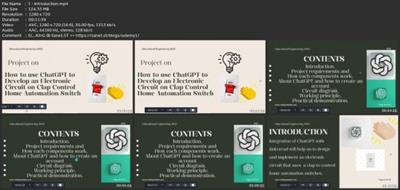- Thread Starter
- #1

How To Use Ai Chatgpt To Design An Electronic Circuit
Published 2/2023
MP4 | Video: h264, 1280x720 | Audio: AAC, 44.1 KHz
Language: English | Size: 663.78 MB | Duration: 1h 19m
Unleash Your Creative Potential with AI ChatGPT-Assisted Electronic Circuit Design
Published 2/2023
MP4 | Video: h264, 1280x720 | Audio: AAC, 44.1 KHz
Language: English | Size: 663.78 MB | Duration: 1h 19m
Unleash Your Creative Potential with AI ChatGPT-Assisted Electronic Circuit Design
What you'll learn
They will learn about the benefits of using AI in electronic circuit design, and what they can expect to gain from the course.
They will understand the scope of the project, the tools and resources they will be using, and the goals they will be striving to achieve.
They will learn how to input circuit design requirements and how to use the outputs of the AI model to guide their design decisions.
They will also learn how to troubleshoot common issues and optimize their use of the tool.
They will learn how to interpret the outputs of the AI model and how to use them to guide their decisions in designing, coding, and testing circuits.
They will learn about the different components of a circuit diagram, and how to ensure that their designs meet project requirements and are optimized for use wi
They will learn about different programming languages, libraries, and frameworks commonly used in electronic circuit design, and how to optimize their code for
Requirements
This course assumes some familiarity with the basics of electronic circuit theory, such as Ohm's Law, Kirchhoff's Laws, and circuit analysis techniques.
The course covers programming topics, so some familiarity with programming languages such as Python, C++, or Java may be helpful.
Students will need access to a computer with internet access in order to access the course materials and complete the assignments.
Description
In this course, you will learn how to use AI techniques to design electronic circuits efficiently and effectively. We will cover the basics of electronic circuit design, including concepts like resistors, capacitors, inductors, and transistors, and then dive into how to use AI algorithms like genetic algorithms, neural networks, and reinforcement learning to optimize circuit designs.We will also explore how to use AI to automatically generate circuit schematics and layout designs, and how to use simulation tools to test and evaluate circuit performance. By the end of the course, you will have a solid understanding of how to use AI to design electronic circuits and be able to apply these techniques to your own projects.Whether you are a beginner or an experienced electronic engineer looking to expand your skills, this course will give you a comprehensive and practical introduction to the exciting world of AI for electronic circuit design.Why you should take this course?The course will be taught using a combination of lectures, hands-on exercises, and real-world case studies. You will have the opportunity to work with popular AI tools and libraries, such as TensorFlow and Keras, and electronic circuit design software, such as LTspice and Eagle.We will also cover best practices for data preprocessing, feature selection, and hyperparameter tuning, to ensure that your AI models are accurate and reliable. You will learn how to interpret the results of your models and use them to guide your design decisions.The course assumes a basic understanding of electronic circuit theory and programming, but no prior experience with AI is required. We will provide all the necessary background and resources to get you up to speed.By the end of the course, you will have a portfolio of AI-powered electronic circuit designs that demonstrate your mastery of the subject. You will also receive a certificate of completion, which you can use to showcase your new skills to potential employers or clients.The course is designed for anyone who is interested in learning how to use AI to design electronic circuits, including hobbyists, students, and professionals in the fields of electronics, computer science, and engineering. If you want to stay ahead of the curve in the rapidly evolving world of electronic circuit design, this course is for you!By the end of the course, students will have a solid foundation in using AI for electronic circuit design, as well as practical experience in applying these techniques to real-world projects. They will have a portfolio of projects that they can showcase to potential employers or clients, and the confidence to continue exploring the possibilities of AI in electronic circuit design.Don't miss out on this opportunity to learn a valuable skill that can save you time and effort in your electronic circuit design projects. Enroll in this Udemy course today and gain a competitive edge in the field. Sign up now and take advantage of our limited-time discount offer to start your journey toward mastering AI for electronic circuit design!
Overview
Section 1: Introduction
Lecture 1 Introduction
Lecture 2 Project requirements
Lecture 3 How to use ChatGPT ep1
Lecture 4 How to use ChatGPT ep2
Lecture 5 How to use ChatGPT ep.3
Lecture 6 Circuit_Diagram
Lecture 7 Coding
Lecture 8 Practical_Testing
Electrical engineering Student,Entrepreneurs or small business owners who want to optimize their electronic circuit designs and increase efficiency with AI-assisted design.,Anyone interested in learning about the latest trends and techniques in AI and electronic circuit design.

Download link
rapidgator.net:
You must reply in thread to view hidden text.
uploadgig.com:
You must reply in thread to view hidden text.
nitroflare.com:
You must reply in thread to view hidden text.

